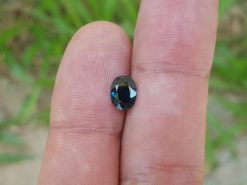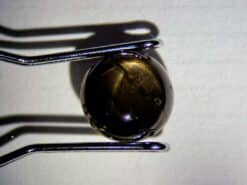Color change sapphire

Natural color change sapphire is a precious gemstone, a variety of the mineral corundum, an aluminium oxide (α-Al2O3).
Buy natural sapphire in our shop
Colour change sapphire
It is typically blue, but natural fancy sapphires also occur in yellow, purple, orange, and green colors, parti sapphires show two or more colors. The only color which sapphire cannot be is red. As a red color corundum is a ruby, another corundum variety.
Pink colored corundum may be either classified as ruby or sapphire depending on locale. This variety in color is due to trace amounts of elements such as iron, titanium, chromium, copper, or magnesium.
Commonly, we cut and polish natural color change sapphires as gemstones and worn it in jewelry. They also can be synthetics for industrial or decorative purposes in large crystal boules. Because of the remarkable hardness of sapphires.
9 on the Mohs scale. The second hardest mineral, after diamond at 10. We also use in some non-ornamental applications. Such as infrared optical components. High-durability windows. Wristwatch crystals and movement bearings. And very thin electronic wafers. It is as the insulating substrates of very special-purpose solid-state electronics.
Color Change
Color change is one of the rarer and more intriguing of gemstone optical phenomena. Unlike pleochroism, its ability does not rely on viewing angle.
With the color change phenomenon, colors can change when gems are viewed under different types of light such as daylight or incandescent light. Only rare gems which formed with multiple light transmission windows can exhibit the ability to color change.
To help understand the phenomenon, a red gemstone appears red because it absorbs all frequencies of light except for red but a color change gemstone that absorbs all frequencies except for blue and red will appear blue when light is rich in blue wavelengths, and will appear red when the light is rich in red wavelengths.
Although alexandrite is the best-known of color change gemstones, the phenomenon can also occur in rare specimens of sapphire, garnet and diaspore-zultanite.
Lab created color change sapphire
The lab created color change Sapphires come under the category of synthetic corundums. Lab created color change sapphires are made by a method called flame fusion.
Natural color change sapphire rough from Madagascar
FAQ
What is color changing sapphire value?
Current prices range for color change sapphires are between $500 to $100,000 on our site depending on the degree of color change, color intensity, stone clarity, cut and of course weight. Very much a case of the 4 Cs rule.
What color of sapphire is most expensive?
In terms of color, pure blue sapphires are the most highly prized, and therefore tend to be the most expensive. This is one of the qualities of the Kashmir sapphire, said to be like “blue velvet” in their appearance.
How can you tell if a color change sapphire is lab created?
Use a magnifying glass or a jeweler’s loupe to check for impurities and flaws within your sapphire. Check for small flaws or specks within the stone. These are an indication that your stone is real. Lab-created sapphires are generally flawless in their composition.
Are color change lab created sapphires worth anything?
In comparison to natural sapphires, lab created sapphires are also less expensive. Natural sapphires demand a high price as they are rare and difficult to mine and involve labor cost as well. Lab created sapphires are easy to make and comparatively more affordable.
Are color change lab created white sapphires durable?
In terms of durability, it is very close to the lab created diamond. Sapphires are known to get a frosty appearance as their facets wear, lab created diamonds remain bright and clear. When it comes to clarity, the sapphire is not even rated on the same scale as a diamond.
Natural sapphire for sale in our gem shop
We make custom made sapphire jewelry as engagement rings, necklaces, stud earrings, bracelets, pendants… Please contact us for a quote.
















